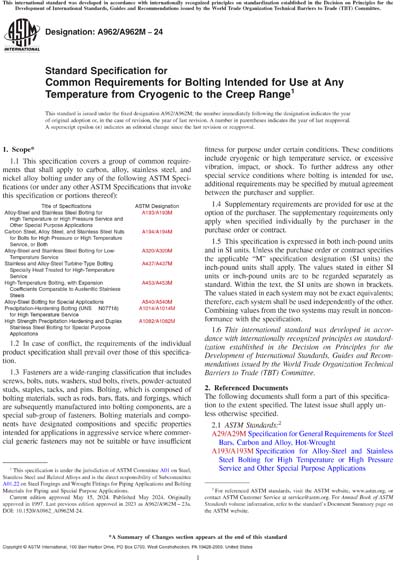Most recent
ASTM A962/A962M-24
Standard Specification for Common Requirements for Bolting Intended for Use at Any Temperature from Cryogenic to the Creep Range
1.1 This specification covers a group of common requirements that shall apply to carbon, alloy, stainless steel, and nickel alloy bolting under any of the following ASTM Specifications (or under any other ASTM Specifications that invoke this specification or portions thereof):
| Title of Specifications | ASTM Designation |
| Alloy-Steel and Stainless Steel Bolting for | A193/A193M |
| Carbon Steel, Alloy Steel, and Stainless Steel Nuts | A194/A194M |
| Alloy-Steel and Stainless Steel Bolting for Low- | A320/A320M |
| Stainless and Alloy-Steel Turbine-Type Bolting | A437/A437M |
| High-Temperature Bolting, with Expansion | A453/A453M |
| Alloy-Steel Bolting for Special Applications | A540/A540M |
| Precipitation-Hardening Bolting (UNS N07718) | A1014/A1014M |
| High Strength Precipitation Hardening and Duplex | A1082/A1082M |
1.2 In case of conflict, the requirements of the individual product specification shall prevail over those of this specification.
1.3 Fasteners are a wide-ranging classification that includes screws, bolts, nuts, washers, stud bolts, rivets, powder-actuated studs, staples, tacks, and pins. Bolting, which is composed of bolting materials, such as rods, bars, flats, and forgings, which are subsequently manufactured into bolting components, are a special sub-group of fasteners. Bolting materials and components have designated compositions and specific properties intended for applications in aggressive service where commercial generic fasteners may not be suitable or have insufficient fitness for purpose under certain conditions. These conditions include cryogenic or high temperature service, or excessive vibration, impact, or shock. To further address any other special service conditions where bolting is intended for use, additional requirements may be specified by mutual agreement between the purchaser and supplier.
1.4 Supplementary requirements are provided for use at the option of the purchaser. The supplementary requirements only apply when specified individually by the purchaser in the purchase order or contract.
1.5 This specification is expressed in both inch-pound units and in SI units. Unless the purchase order or contract specifies the applicable “M” specification designation (SI units) the inch-pound units shall apply. The values stated in either SI units or inch-pound units are to be regarded separately as standard. Within the text, the SI units are shown in brackets. The values stated in each system may not be exact equivalents; therefore, each system shall be used independently of the other. Combining values from the two systems may result in nonconformance with the specification.
1.6 This international standard was developed in accordance with internationally recognized principles on standardization established in the Decision on Principles for the Development of International Standards, Guides and Recommendations issued by the World Trade Organization Technical Barriers to Trade (TBT) Committee.
ASTM International [astm]

